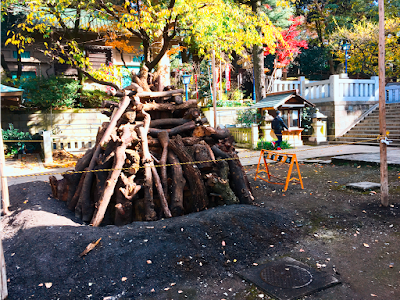From Bujinkan Santa Monica by Michael
 |
| 五條天神社で、お焚き上げ otakiage preparations at Gojoten jinja. photo Michael Glenn |
Happy new year! This year makes more than 35 years in the Bujinkan for me. I am humbled by the many gifts training has given me during all these years. But I still feel excited for what the future holds.
Our 初稽古 Hatsugeiko, or the first training of the new year, was a bit different this year. For one, we actually trained on January 1, 2022. This is a holiday for most people, but many of us choose the dojo for holidays anyway! I know many of you have used your vacation time to train in Japan.
And second, I have reached that point in life where many important teachers and students that I trained with are no longer training at all. Some have died, some have quit training. Either way, I made my hatsugeiko in their honor.
For our first training of the year, I put a strong focus on kihon. It was cold, so I didn’t have to convince anyone to warm up. We all trained hard and got sweaty.
We warmed up with ukemi and taihenjutsu including: 前方廻転 zenpō kaiten; 後方廻転 kōhō kaiten; 側方廻転 sokuhō kaiten; 前方蛙廻転 zenpō kaeru kaiten; 後方蛙廻転 kōhō kaeru kaiten; 横転 ōten; and 無手横転 mute ōten. Then we did 初心五型 shoshin gokei, 基本八法 Kihon Happō and even found time for bōjutsu basics.
The first training of the new year sets the tone for the rest of the year. It is important to approach it with sincerity and a focus that will bring you the results that you want from your training. As I told my students, I am not teaching you. I can show you things and act as an example of where you can go. But in the dojo and in life you are all teaching yourselves.
Next, we continued our study of 投型 nage kata from last year with 逆投 Gyaku Nage. I worked off of my notes from my studies with Oguri Sensei in Japan. We must keep his taijutsu and training spirit alive even in 2022! I spent some time demonstrating important details for using a makikomi in this waza. Hatsumi Sensei gave us this advice,
Everyone moves with their head, but you have to move with your center here. 伸ばす nobasu, stretch him out then enter from the side.
It is interesting to move with your own center this way. Not ducking under. Not lifting the opponent’s arm. But changing your center to shape the kukan.
For me, Bujinkan training is a central part of my entire life. Maybe it is for you too. Maybe we can move with our center into the new year. This is a way to shape the future from a strong foundation.…
Read More
